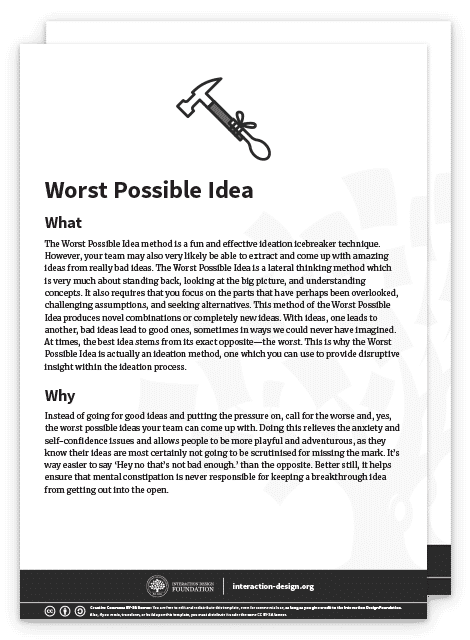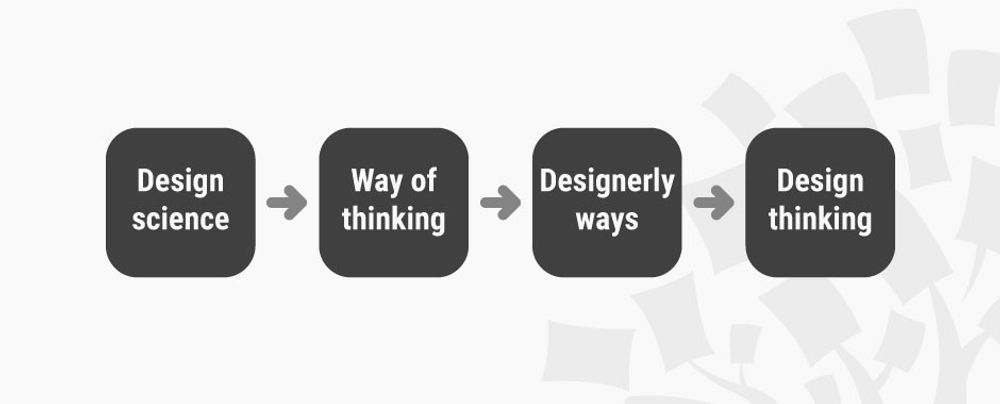We all know what it is like when someone calls for new ideas. At first, no one wants to say anything; most people tend to wait to hear what others have to say, and—if they feel that their ideas are not as great—they may bottle up what they're thinking. Worst Possible Idea is a highly effective method that you can use to get the creative juices flowing and help those not so confident in expressing themselves by flipping the brainstorm on its head. And it’s a lot of fun, too.
Instead of going for good ideas and putting the pressure on, call for the worst and, yes, the worst possible ideas your team can come up with. Doing this relieves the anxiety and self-confidence issues and allows people to be more playful and adventurous, as they know their ideas are most certainly not going to be scrutinized for missing the mark. It's way easier to say “Hey no that's not bad enough.” than the opposite. Better still, it helps ensure that mental constipation is never responsible for keeping a breakthrough idea from getting out into the open.
In Idea Stormers, the author and innovation guru to Fortune 500 companies, Bryan Mattimore, recalls a scenario where he was trying to get a group of bankers to come up with innovative ideas. They had gone through hours of ideation sessions and had come up with nothing worth considering. Mattimore introduced the Worst Possible Idea method as a last resort. As soon as the first of the bankers had thrown out a terrible suggestion, the rest of the group quickly joined in and finally had some fun as well, opening up the way for positive ideation sessions later.
The Worst Possible Idea or Worst Idea technique is not purely an icebreaker-style technique, though, as insights that may stem from really bad ideas may even be useful in generating really great ideas. On that note, it doubles as a—really fun—process of elimination.
“To invent, you need a good imagination and a pile of junk.”
– Thomas Edison, American inventor who developed the phonograph, the motion picture camera and the electric light bulb. As quoted in Behavior-Based Robotics (1998) by Ronald C. Arkin. p. 8

The Worst Possible Idea method is a fun and effective ideation icebreaker technique. However, your team may also very likely be able to extract and come up with amazing ideas from really bad ideas.
© Daniel Lobo, CC BY 2.0.
Best Practice: How
The technique is simple:
The facilitator briefs the ideation session participants about the problem statement (also called Point Of View), the overall goals and important user insights.
Then the facilitator asks the participants to come up with the worst possible ideas they can think of. There should be permission given to revel in unusable, impractical, stupid or foolish ideas; ones that are nonsensical, ridiculous, incorrect, mismatched, and against known best-practices, laws or guidelines. The intention is not necessarily to descend into toxic or gratuitously offensive concepts (the facilitator will need to use their judgement to keep the ideation session happy and healthy) but to escape constraints by opening the mind. You can do this as a collective brainstorm session, or you can ask all participants to write down their worst ideas individually—this method is called Braindumping. You could also use the Brainwriting method, where each participant fills out idea cards/papers with their worst possible ideas for 3–5 minutes and then passes on the idea card to another participant, who elaborates on their worst possible ideas, and so forth.
As the facilitator, be sure to push your group to generate extremely bad ideas! This will help get participants laughing and re-engaged. As a facilitator of ideation sessions, it’s your job to help participants open their minds and hearts, and the Worst Idea method can help you do just that—especially if you combine it with the collective Brainstorm method.
The technique includes generating as many terrible ideas as possible.
It includes listing the attributes of the worst ideas.
Investigate which attributes of the ideas make them really bad.
Once the participants have generated a list of their worst ideas, you as the facilitator should challenge the group to turn those horrible ideas into good ones. They can either consider the ideas’ opposites or look for aspects within the terrible ideas that might inspire a good one. Or, you can consider simply removing the worst attribute and replacing it with something else. Mix and match different bad ideas, and see what comes out.
Why
A closed mind will not be able to build on external stimuli. We've all witnessed this in some way or another—a person who is convinced that their own ideas are better than anyone else's becomes oblivious to the value of the contributions others have made. Group ideation functions best when all ideas can be expressed equally and then later mixed up in unconventional ways. This approach by the Worst Possible Idea produces novel combinations or completely new ideas. With ideas, one leads to another; bad ideas lead to good ones, sometimes in ways we could never have imagined. At times, the best idea stems from its exact opposite—the worst. This is why the Worst Possible Idea is actually an ideation method, one which you can use to provide disruptive insight within the ideation process.
This is a lateral thinking technique which seeks to solve problems through an indirect and creative approach. It’s all about using reasoning that is not immediately obvious and involving ideas that may not be obtainable by using only traditional step-by-step logic. The purpose of lateral thinking is to help us break out of rigid thought patterns and to generate unpredictable and innovative ideas. Lateral thinking seeks to arrive at unknown solutions, as opposed to vertical thinking, which operates directly on perceivable data and analysis. Not for nothing are the horizons—and, by association, the possibilities—broader with lateral thinking.
Do you want to learn how you can get started using the Worst Possible Idea methods to break the ice and help open up participants’ minds? Then download and print our Worst Possible Idea template:


The Take Away
The Worst Possible Idea method is a fun and effective ideation icebreaker technique. However, your team may also very likely be able to extract and come up with amazing ideas from really bad ideas. The Worst Possible Idea is a lateral thinking method which is very much about standing back, looking at the big picture and understanding concepts. It also requires that you focus on the parts that have perhaps been overlooked, challenging assumptions and seeking alternatives. It’s a great way of zeroing in on what will work by exposing what won’t, but then working out or working back elements from these “dud ideas” that may have a bearing on the true solution to the problem at hand.
References & Where to Learn More
Bryan Mattimore, Idea Stormers: How to Lead and Inspire Creative Breakthroughs, 2012.
Edward de Bono, New think: The use of lateral thinking in the generation of new ideas, 1967
Edward de Bono, Lateral thinking: Creativity Step by Step, 1970
Edward De Bono, De Bono Thinking.
The de Bono Group. Six Thinking Hats: http://www.debonogroup.com/six_thinking_hats.php
PDAgroup Blog. Design Thinking: The Ideal Design Space, 2013.
Ella Miron-Spektor, Miriam Erez, and Eitan Naveh, To Drive Creativity, Add Some Conformity, Harvard Business Review, March 2012.
Bob Riley, The Provocation Creative Technique, ThoughtEgg.com.
Maria Giudice and Christopher Ireland, Rise of the DEO - Leadership by Design.
Images
Hero Image: © Richard Masoner / Cyclelicious, CC BY-SA 2.0.











